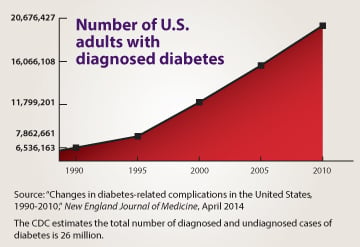The number of U.S. adults reporting a diagnosis of diabetes more than tripled over the past two decades, according to a study published this month in the New England Journal of Medicine. At the same time, the rates of all five major diabetes complications declined significantly, suggesting the importance of screening and prevention work.
According to the study, diagnosed diabetes increased from 6.5 million in 1990 to 20.7 million in 2010. Rates of heart attacks, strokes, kidney failure and amputations fell sharply over the same period, with the largest declines in the rates of heart attacks and deaths resulting from high blood sugar. It is estimated that the total number of diabetes cases, both diagnosed and undiagnosed, is 26 million.
While identifying cases of diabetes has improved, more needs to be done to identify patients who are at risk and help them prevent the onset of the disease.
A related study published this month in the Annals of Internal Medicine found that the prevalence of undiagnosed diabetes remained fairly stable, leading to a decrease in the proportion of total undiagnosed cases of diabetes to 11 percent in 2005–2010. The study also found that diabetes prevalence was greater and diabetes was less controlled among non-Hispanic blacks and Mexican Americans.
“Although the CDC is actively engaged in adapting the Diabetes Prevention Program model for the community, we need to ensure that adequate resources are allocated to target these issues at the individual, societal and environmental levels,” physicians at the Joslin Diabetes Center and Harvard Medical School in Boston wrote in an accompanying editorial in the Annals of Internal Medicine. “Indeed, the public and private sectors need to work closely together to tackle this immense problem.”
As part of its Improving Health Outcomes initiative, the AMA is focusing on systematic prevention of diabetes to save lives, improve health and reduce health care spending.
Research estimates that a pending Medicare bill, the Medicare Diabetes Prevention Act, could save $1.3 billion in federal spending over the next decade by covering the participation of eligible Medicare beneficiaries in the evidence-based National Diabetes Prevention Program developed by the Centers for Disease Control and Prevention (CDC).
The research, conducted by Avalere Health, found that such coverage could reduce the cumulative rate of diabetes in the Medicare population by an estimated 37 percent after 10 years, resulting in nearly 1 million fewer cases of diabetes among seniors by 2024.
The AMA is piloting the creation of clinical-community linkages with the YMCA, establishing a process for physicians to increase screening for prediabetes and refer patients to the YMCA’s Diabetes Prevention Program in their community.
The program is kicking off at locations in four states. Pilot sites in Indiana, Minnesota and Delaware have been announced, and a fourth location will be announced in the coming months.




